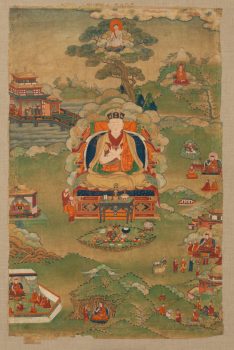Kham Region, Eastern Tibet
19th century
This gesture is that of embracing a consort and is symbolic of bringing together two aspects of enlightenment: wisdom and method.
Kham Region, Eastern Tibet
19th century


Presented largely in tones of green, this painting’s grassy highland with hills and remote mountains forms the backdrop for the central figure of the Karmapa and the surrounding scenes from his life. Although the landscape provides a sense of depth, the sizes of the figures do not conform to the perspective but rather relate to the importance of the depicted figure. Most of the scenes are placed at the very edge of the canvas and thus further emphasize the landscape setting. Unusual is the large tree behind the main figure with a whiteclad yogin sitting in it. The central Karmapa holds a vajra and bell in his hands crossed in front of his breast, associating him with Buddha Vajradhara. Although telling details are scarce there is one scene that leaves no doubt that this is the Third Karmapa, Rangjung Dorje (1284–1339). In the scene at the middle of the painting’s left edge, a child, seated on a throne between his parents, puts a black hat on his head, as did the Third Karmapa at the age of three. The top left scene stresses the international importance of this teacher, as the Karmapa is shown seated in a pavilion giving teachings to the emperor of China. While this Yuan emperor, Toghan Temur (r. 1333-1370) was Mongolian, he is depicted in this much later painting following standard conventions for depicting Chinese emperors.
A virtuous feeling and deep respect toward an authentic teaching, teacher, or path. Buddhists believe that expansive study, analysis, and meditation are essential steps for cultivating a healthy and enduring devotion.
Teachings and precepts that offer practical and experiential guidance. In Buddhism instruction is primarily an oral tradition and is often targeted to the specific needs or disposition of a student or disciple.
A vehicle for the preservation and transmission of knowledge. The Buddha’s teachings were originally passed down through oral transmission and storytelling, and stories of the Buddha’s past lives are considered an important source of inspiration and guidance.
The transmission of teachings from one generation to the next, from teacher to student, traced all the way back to the Buddha without interruption. A complete lineage is essential in Tantric Buddhist practices as it makes the blessings of the teaching more powerful.
Himalayan art includes portraits of legendary and historical humans, including accomplished religious teachers (lamas), the Buddha’s original disciples (arhats), and spiritually accomplished tantric masters (mahasiddhas).
Today, Tibetans primarily inhabit the Tibetan Plateau, situated between the Himalayan mountain range and the Indian subcontinent to the west, Chinese cultural regions to the east, and Mongolian cultural regions to the northeast. During the 7th to 9th century, Tibetan rulers expanded their empire across Central Asia, and established Buddhism as the state religion.
Get the latest news and stories from the Rubin, plus occasional information on how to support our work.